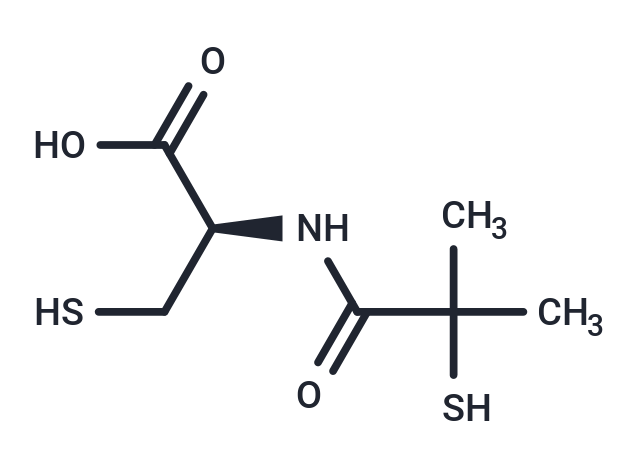Shopping Cart
Remove All Your shopping cart is currently empty
Your shopping cart is currently empty
Bucillamine (DE019) protects against Ischemia/reperfusion injury in high-risk organ transplants and inhibits the production of VEGF. Bucillamine is an orally active sulfhydryl donor and antioxidant with antirheumatic and antiangiogenic properties. Bucillamine can be used for studies about choroidal neovascularization and rheumatoid arthritis.

| Pack Size | Price | USA Warehouse | Global Warehouse | Quantity |
|---|---|---|---|---|
| 25 mg | $33 | In Stock | In Stock | |
| 50 mg | $56 | In Stock | In Stock | |
| 100 mg | $93 | In Stock | In Stock | |
| 200 mg | $137 | In Stock | In Stock | |
| 1 mL x 10 mM (in DMSO) | $29 | In Stock | In Stock |
| Description | Bucillamine (DE019) protects against Ischemia/reperfusion injury in high-risk organ transplants and inhibits the production of VEGF. Bucillamine is an orally active sulfhydryl donor and antioxidant with antirheumatic and antiangiogenic properties. Bucillamine can be used for studies about choroidal neovascularization and rheumatoid arthritis. |
| In vivo | In rats subjected to liver transplants, Bucillamine significantly enhances survival and protected against hepatic injury[2]. Subconjunctival injection of Bucillamine significantly reduces the leakage and size of experimental CNV in rats[3]. |
| Synonyms | Tiobutarit, Thiobutarit, SA96, DE-019, DE019, DE 019 |
| Molecular Weight | 223.31 |
| Formula | C7H13NO3S2 |
| Cas No. | 65002-17-7 |
| Smiles | [C@@H](NC(C(C)(C)S)=O)(C(O)=O)CS |
| Relative Density. | 1.289 g/cm3 |
| Color | White |
| Appearance | Solid |
| Storage | Powder: -20°C for 3 years | In solvent: -80°C for 1 year | Shipping with blue ice/Shipping at ambient temperature. | |||||||||||||||||||||||||||||||||||
| Solubility Information | DMSO: 25 mg/mL (111.95 mM), Sonication is recommended. | |||||||||||||||||||||||||||||||||||
Solution Preparation Table | ||||||||||||||||||||||||||||||||||||
DMSO
| ||||||||||||||||||||||||||||||||||||
| Size | Quantity | Unit Price | Amount | Operation |
|---|

Copyright © 2015-2025 TargetMol Chemicals Inc. All Rights Reserved.